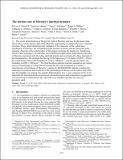| dc.contributor.author | Hauck, Steven A. | |
| dc.contributor.author | Margot, Jean-Luc | |
| dc.contributor.author | Solomon, Sean C. | |
| dc.contributor.author | Phillips, Roger J. | |
| dc.contributor.author | Johnson, Catherine L. | |
| dc.contributor.author | Lemoine, Frank G. | |
| dc.contributor.author | Mazarico, Erwan Matias | |
| dc.contributor.author | McCoy, Timothy J. | |
| dc.contributor.author | Padovan, Sebastiano | |
| dc.contributor.author | Peale, Stanton J. | |
| dc.contributor.author | Perry, Mark E. | |
| dc.contributor.author | Smith, David Edmund | |
| dc.contributor.author | Zuber, Maria | |
| dc.date.accessioned | 2014-03-14T17:06:37Z | |
| dc.date.available | 2014-03-14T17:06:37Z | |
| dc.date.issued | 2013-06 | |
| dc.date.submitted | 2013-02 | |
| dc.identifier.issn | 21699097 | |
| dc.identifier.uri | http://hdl.handle.net/1721.1/85633 | |
| dc.description.abstract | The recent determination of the gravity field of Mercury and new Earth-based radar observations of the planet's spin state afford the opportunity to explore Mercury's internal structure. These observations provide estimates of two measures of the radial mass distribution of Mercury: the normalized polar moment of inertia and the fractional polar moment of inertia of the solid portion of the planet overlying the liquid core. Employing Monte Carlo techniques, we calculate several million models of the radial density structure of Mercury consistent with its radius and bulk density and constrained by these moment of inertia parameters. We estimate that the top of the liquid core is at a radius of 2020 ± 30 km, the mean density above this boundary is 3380 ± 200 kg m−3, and the density below the boundary is 6980 ± 280 kg m−3. We find that these internal structure parameters are robust across a broad range of compositional models for the core and planet as a whole. Geochemical observations of Mercury's surface by MESSENGER indicate a chemically reducing environment that would favor the partitioning of silicon or both silicon and sulfur into the metallic core during core-mantle differentiation. For a core composed of Fe–S–Si materials, the thermodynamic properties at elevated pressures and temperatures suggest that an FeS-rich layer could form at the top of the core and that a portion of it may be presently solid. | en_US |
| dc.description.sponsorship | United States. National Aeronautics and Space Administration (NASA MESSENGER Participating Scientist grant NNX07AR77G) | en_US |
| dc.language.iso | en_US | |
| dc.publisher | American Geophysical Union | en_US |
| dc.relation.isversionof | http://dx.doi.org/10.1002/jgre.20091 | en_US |
| dc.rights | Article is made available in accordance with the publisher's policy and may be subject to US copyright law. Please refer to the publisher's site for terms of use. | en_US |
| dc.source | MIT web domain | en_US |
| dc.title | The curious case of Mercury's internal structure | en_US |
| dc.type | Article | en_US |
| dc.identifier.citation | Hauck, Steven A., Jean-Luc Margot, Sean C. Solomon, Roger J. Phillips, Catherine L. Johnson, Frank G. Lemoine, Erwan Mazarico, et al. “The Curious Case of Mercury’s Internal Structure.” Journal of Geophysical Research: Planets 118, no. 6 (June 2013): 1204–1220. | en_US |
| dc.contributor.department | Massachusetts Institute of Technology. Department of Earth, Atmospheric, and Planetary Sciences | en_US |
| dc.contributor.mitauthor | Mazarico, Erwan Matias | en_US |
| dc.contributor.mitauthor | Zuber, Maria | en_US |
| dc.contributor.mitauthor | Smith, David Edmund | en_US |
| dc.relation.journal | Journal of Geophysical Research: Planets | en_US |
| dc.eprint.version | Final published version | en_US |
| dc.type.uri | http://purl.org/eprint/type/JournalArticle | en_US |
| eprint.status | http://purl.org/eprint/status/PeerReviewed | en_US |
| dspace.orderedauthors | Hauck, Steven A.; Margot, Jean-Luc; Solomon, Sean C.; Phillips, Roger J.; Johnson, Catherine L.; Lemoine, Frank G.; Mazarico, Erwan; McCoy, Timothy J.; Padovan, Sebastiano; Peale, Stanton J.; Perry, Mark E.; Smith, David E.; Zuber, Maria T. | en_US |
| dc.identifier.orcid | https://orcid.org/0000-0003-2652-8017 | |
| dspace.mitauthor.error | true | |
| mit.license | PUBLISHER_POLICY | en_US |
| mit.metadata.status | Complete | |
